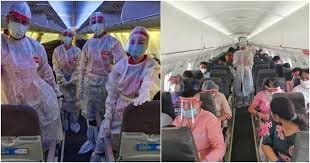Coronavirus transmission: While the risk of transmission on an aircraft is low, flyers can take additional precautions to further lower risk, said IATA.
Only seven out of three million passengers on flights in recent weeks showed symptoms of the virus while on board, according to the European Union Aviation Safety Agency (EASA).
Both domestic and international flights are being resumed in a calibrated manner. However, apprehension over the possibility of catching coronavirus during a flight journey still looms large. Centers for Disease Control and Prevention (CDC) in the US has published two studies pertaining to two flights — London-Hanoi and Boston-Hong Kong — and looked into the possibilities of catching Covid-19 on a flight.
In its studies “In-Flight Transmission of Severe Acute Respiratory Syndrome Coronavirus 2”, the CDC stated “Four persons with severe acute respiratory syndrome coronavirus 2 infection had traveled on the same flight from Boston in Massachusetts, USA, to Hong Kong, China. Their virus genetic sequences are identical, unique, and belong to a clade not previously identified in Hong Kong, which strongly suggests that the virus can be transmitted during air travel.”
During its second study, the CDC noted “Among the 217 passengers and crew members on a direct flight from London to Hanoi in early March 2020, we identified a cluster of 16 laboratory-confirmed COVID-19 cases. In-depth epidemiologic investigations strongly suggest that 1 symptomatic passenger (case 1) transmitted SARS-CoV-2 infection during the flight to at least 12 other passengers in business class (probable secondary cases).”
However, the International Air Transport Association (IATA) has said that the two flight studies took place in March. There have been millions of flights since the start of the COVID-19 outbreak. And there are very few reported incidents where onboard transmission is suspected, IATA stated. IATA asserted that the data is revealing that the risk of onboard transmission of the Coronavirus is low when compared with other public indoor environments, such as trains, buses, restaurants and workplaces. IATA said that aircraft benefit from very high air exchange rates and HEPA filters which clear more than 99.99 per cent of all particles including viruses.
While the risk of transmission on an aircraft is low, flyers can take additional precautions to further lower the risk. Following guidance to wear a mask or face covering provides significant protection to all onboard. Flyers are also encouraged to practice good hand hygiene – washing hands regularly with soap or an alcohol-based hand sanitizer, and avoiding touching the eyes, nose or mouth, especially after contact with commonly touched surfaces, IATA stated. IATA said that it would continue to keep an open mind and a close watch on emerging data and medical literature.
The risks of air travellers catching COVID-19 on a passenger aircraft are “very marginal” provided health measures are applied, Europe’s top aviation safety regulator said. Only seven out of three million passengers on flights in recent weeks showed symptoms of the virus while on board, according to the European Union Aviation Safety Agency (EASA). The risks are “highly controlled” by airline and airports, Executive Director Patrick Ky said, as per Reuters report.

